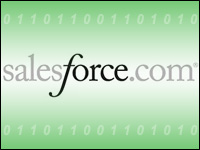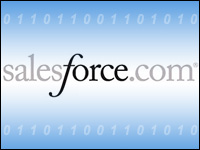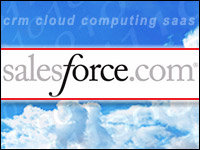
UPDATE: 2:21 PM PT, 9/2/11: They call it a Q&A session, but when Salesforce CEO Marc Benioff takes questions, he draws the kind of crowd in front of which you often see politicians performing. The group has gotten too big for me to know everyone or even most people — especially since it includes press, financial analysts and industry analysts.
I have the pleasure of hanging with some of the sharpest minds in the analyst world, including Paul Greenberg, Esteban Kolsky, Brent Leary, Jesus Hoyos, Josh Weinberg and a slew of people I only know by reputation inside an ad hoc group called the “Enterprise Irregulars.” If there’s good analysis coming out of Dreamforce or anywhere else where we converge, it’s because of them.
The press conference is our chance to ask Marc directly anything about the business and the technology, and it’s amazing what this guy keeps in his head. Here are some examples:
On Salesforce’s accounting methods: Someone referenced a recent story in the financial press about how Salesforce was using some questionable accounting methods. Benioff set the record straight, saying that the referenced methods were the ones used by conventional software companies, not Software as a Service (SaaS) companies. Without getting into the weeds, recognizing revenue is different for these two groups, and before going public, Salesforce did a lot of due diligence to document its approach, leaning on world-class accounting experts. Today, the path laid down by Salesforce is largely the one used by other SaaS companies. So there.
On retiring the no-software idea: It’s not time for that yet. Too many people still don’t get it, as evidenced by what Benioff calls the “false clouds” in the market. As long as other vendors try to claim cloud parity with new marketectures, Salesforce will be selling the no-software idea.
On the market in general: While Salesforce has done well, it’s no time to circle the wagons. Social principles have made everything new again, and most of the world needs to catch on, so Salesforce is in growth and market share acquisition mode and will be for a long time.
On the economy: While it might not be great, the companies Salesforce deals with are growing, and Salesforce must stay ahead of the hiring curve. Today, it has roughly 1,000 open job requisitions. While the economy might not be in great shape, Salesforce continues to execute and delivered 38 percent growth year-over-year in its second quarter. Not too shabby.
Like any good pol, Marc announced that it’s his intent to answer all of the questions the group has. He seems to relish being in front of the crowd and talking about his favorite subject.
UPDATE: 9:19 AM PT, 9/2/11: Necessity is the mother of invention, and last year when Bill Clinton was late for the closing keynote, Salesforce CEO Marc Benioff may have discovered an ideal medium for closing out Dreamforce. This year, he perfected it.
I don’t know if Clinton was scheduled to give a conventional speech last year or a sit-down interview. I only know that in selecting Stevie Wonder as an interview subject, the limitations of the situation bred a new kind of closing ceremony and enabled a new level of customer or audience intimacy. Mr. Wonder is many things, but one thing he is not is a stump speaker like the former president. In selecting Wonder, Benioff had to accept that limitation, and from it, the interview format was a natural outcome. But who knew the Marc could be such an engaging interrogator and listener?
This year the interview was established and organized as much as such a thing can be. In selecting Eric Schmidt, chairman of Google, Benioff called on a friend of several decades, a former colleague at Oracle and an individual who has, by any measure, lived the life of a highly successful Silicon Valley entrepreneur and innovator. Benioff and Schmidt spent more than an hour discussing the evolution of their industry and setting what Dreamforce had been all about in that context. When you left, it was still possible to think of an alternative universe, but only with great difficulty.
In fact, there is no alternative universe. You get what you have, and what we all have is an industry that is leading business into the new century and a new era. That era is mobile and social, it is connected physically and emotionally, and increasingly the connectors are technologies. It is also rapidly iterative, and Salesforce was careful within Dreamforce to ensure it touched all bases.
Benioff’s breakthrough with Schmidt at this year’s Dreamforce was the realization that other people could carry the ball and deliver the same kind thought leadership that Salesforce is delivering. Salesforce has always been about extending thought leadership, about getting people to imagine a world without the complexities of conventional IT. The closing interview didn’t just expand that franchise; it sent a lot of people home knowing they were on the right track and doing something important.
UPDATE: 11:16 AM PT, 9/1/11: The combination of Heroku and Database.com is especially interesting.
Heroku is the tool set you might use to quickly build a social Web-based application for your website, Facebook or another Web property. The product demos well, and the video describing the solution involved the new “Harry Potter” movie from Warner Bros.
The Web presents special challenges for developers, as the solutions you build need to be able to scale from nothing to millions very quickly. That’s the market Salesforce is aiming Heroku at, while Force.com is for more traditional business applications — though, of course, there will be overlap. For instance Heroku is billed as a multi-language platform and an addition to Ruby, which developers swear by, but it also supports Java.
This could be interesting.
UPDATE: 10:53 AM PT, 9/1/11: It’s too early to say for sure because Dreamforce is not over, but it looks to me like the platform and tool announcements might eclipse the applications announcements here. Here are some of the things that caught my eye:
Touch. Salesforce.com gives you the ability to run a Salesforce application on a mobile device with device-specific controls. Think about pinching an iPad screen as an example, or leafing through pages.
Database.com went GA last night. This cloud resident database is intended to support applications built for cloud apps with Force.com and Heroku. It works with other languages as well. Early demand is strong, and it’s free to get started.
More importantly, Database.com supports a social data model, shared security model RESTful APIs, tool kits, workflow and sharp screens with drag-and-drop development capability.
Database.com gives customers the ability to store and access Salesforce data on local devices.
Of course, this means war. As big as the CRM market is, the market for tools and databases is much bigger, and Salesforce is challenging 20-year-old products and paradigms from companies like Oracle and Microsoft. I expect a vigorous response. It’s one thing for Salesforce to take over the CRM market, but the platform market is the bread and butter of these older companies.
Yup, war.
10:02 AM PT, 9/1/11: One of the announcements Marc Benioff made in his Day 1 keynote here at Dreamforce was Database.com. The news is that Salesforce is now enabling its customers to store their data on their own hardware inside their data centers.
There is a need — or at least a demand — for this capability, as many large enterprises and government institutions do not wish to send, or are prohibited from sending, their data outside of their own four walls. In some geographies, they can’t let data cross national borders. So in Europe, for instance, that would at least in theory mean a need for a Salesforce data center in each locale. That’s clearly not going to happen, so the move to in-house storage makes a certain amount of sense.
Nonetheless, this also introduces a new level of complexity to the situation and potentially makes cloud computing less rather than more stable. With more points of physical integration and storage, individual customers are paradoxically now at their own mercy. If their storage goes down, who do they point fingers at?
This certainly takes a little wind out of the sails of the competition, who have been hammering on the idea that their solutions are more configurable because they offer on-premise options. That’s getting to be a difference without a distinction.
Most importantly, the software stays in the cloud, where Salesforce can manage and upgrade it. Multi-tenancy lives on, and perhaps this concession to storage will bring more people into the fold.























































